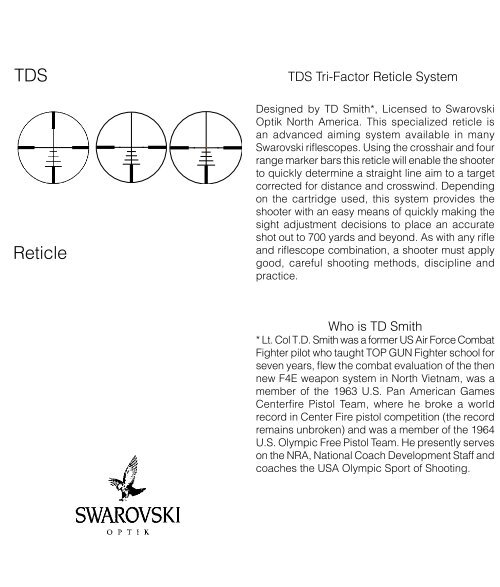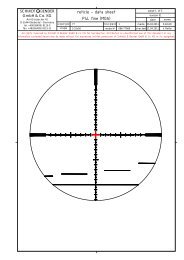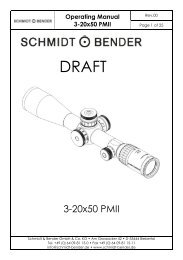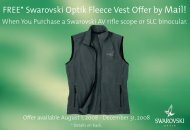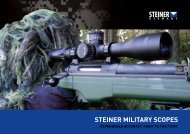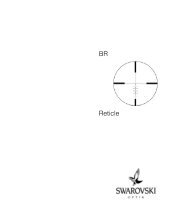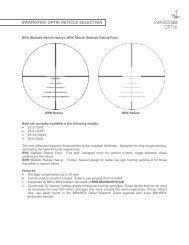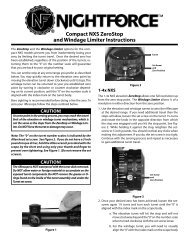You also want an ePaper? Increase the reach of your titles
YUMPU automatically turns print PDFs into web optimized ePapers that Google loves.
<strong>TDS</strong><strong>Reticle</strong><strong>TDS</strong> Tri-Factor <strong>Reticle</strong> SystemDesigned by TD Smith*, Licensed to SwarovskiOptik North America. This specialized reticle isan advanced aiming system available in manySwarovski riflescopes. Using the crosshair and fourrange marker bars this reticle will enable the shooterto quickly determine a straight line aim to a targetcorrected for distance and crosswind. Dependingon the cartridge used, this system provides theshooter with an easy means of quickly making thesight adjustment decisions to place an accurateshot out to 700 yards and beyond. As with any rifleand riflescope combination, a shooter must applygood, careful shooting methods, discipline andpractice.Who is TD Smith* Lt. Col T.D. Smith was a former US Air Force CombatFighter pilot who taught TOP GUN Fighter school forseven years, flew the combat evaluation of the thennew F4E weapon system in North Vietnam, was amember of the 1963 U.S. Pan American GamesCenterfire Pistol Team, where he broke a worldrecord in Center Fire pistol competition (the recordremains unbroken) and was a member of the 1964U.S. Olympic Free Pistol Team. He presently serveson the NRA, National Coach Development Staff andcoaches the USA Olympic Sport of Shooting.
<strong>TDS</strong> Tri-Factor <strong>Reticle</strong> SystemThe <strong>TDS</strong> reticle system is designed to accurately placea shot from short to very long distances without anyadjustments of the turrets. This reticle is designed toperform several different tasks.The first is to take the guesswork out of holdover byusing the short horizontal lines called marker bars.All <strong>TDS</strong> scopes come with 12 factor decals and 3blanks. You have to first choose which decal to usedepending on the cartridge you are using. This decalwill represent different yardage points on the mainhorizontal crosshair and 4 marker bars.You first have to determine what factor number is correctfor your rifle and cartridge. The factor number issimply the bullet drop in inches from 200 to 300 yardswith a 200 yard zero. For example, you are firing a30-06 180 grain Nosler Partition bullet at 2700 feet persecond. Ballistic data will show that this bullet will drop8.5 inches at 300 yards with a 200 yard zero so thefactor will be 8.5. In this case you would use the decalthat says “Factors 8-9.5”. On this decal the main horizontalcrosshair would be 100 yards, the 1 st marker bar200 yards, the 2 nd marker bar 300 yards, the 3 rd markerbar 400 yards and the 4 th marker bar 450 yards.Here’s an example of the same bullet in a differentcartridge at a faster velocity. You are firing a .300Weatherby <strong>Magnum</strong> with a 180 grain Nosler Partition at3240 feet per second. With a 200 yard zero the bulletwill be dropping 5.5 inches at 300 yards. Since thefactor is 5.5 you would use the decal that says “Factors4.7-5.7”. On this decal the 100, 200 and 300 yardpoints will all be on the main horizontal crosshair, the1 st marker bar 400 yards, the 2 nd marker bar 500 yards,the 3 rd marker bar 600 yards and the 4 th marker bar700 yards.Another feature of the <strong>TDS</strong> system is that you cancorrect for wind. Each end of the marker bars are calibratedfor a 10 mph crosswind from the center verticalline. If you have a 10 mph wind blowing from right toleft and you’ve determined the animal is 400 yardsaway, your decal shows 400 yards is the 3 rd marker bardown, hold the left end of that marker bar where youwant the bullet to hit.Distance to a target can also be determined with the<strong>TDS</strong> system. You must first know the chest depth of theanimal you are hunting. There is a chest depth chart formost big game animals in the back of this instructionmanual. On every <strong>TDS</strong> decal there are also numberson the left side of the decal descending verticallyfrom 0 to 11. This series of numbers is called the gridline. Now suppose you are hunting an elk with a chestdepth of 24 inches. To determine the range place themain horizontal crosshair on the top of the back at theshoulder area. Look to see where the bottom of thechest lines up in relation to the marker bars. Say in thiscase the bottom of the chest falls just slightly below the3 rd marker bar. Look at the decal to see what grid linenumber is at that same point where the bottom of thechest is. You will find that number 8 most closely corresponds.Take that 8 and divide it into the chest depth of24 to get 3, multiply that 3 times 100 to get 300 yardsaway. Now use the 300 yard bar on the reticle and fire.The <strong>TDS</strong> reticle can also compensate for trajectoriesfired at sharp angles say from 30 to 45 degrees. Mostpeople have a tendency to shoot high in these situations.Bullet trajectories are figured over a horizontalplane. If you have a 500 yard shot at an animal theballistics are pretty straightforward. If you have thatsame 500 yard shot at a 45 degree angle, up or down,the effect of gravity on the bullet will be over a muchshorter distance. This is a case where most people willhave a tendency to shoot too high. In this scenario withthe <strong>TDS</strong> system you simply move from the 500 yardmarker bar to the 400 yard marker bar.12
Factor InformationSwarovski Optik has a simple method that allows ashooter to match up his or her rifle / cartridge informationto what the marker bars will indicate for yardagedistances by first determining a “Factor Number”. Thisfactor number will be a number like 5.4, 6.2 or 8.7.Once you know what your “Factor Number” is you canthen match it up to one of the decals or stickers thatare supplied with your <strong>TDS</strong> rifle scope. The “FactorNumber” is the bullet’s drop in inches, from 200 to300 yards, with a 200 yard zero. Swarovski providesa “Factor” chart in the back of this manual for manypopular calibers. If you can not find your cartridge inthis chart there are several other ways to determine theproper factor. This factor number can also be found inmany a<strong>mm</strong>unition manufacturer’s ballistic tables (eitherfrom catalogs or their internet sites), various ballisticprograms, or by actually going out and shooting andmeasuring. You can also use the Swarovski Optik <strong>TDS</strong>Ballistic Calculator on www.swarovskioptik.com. Clickon “products”, “rifle scopes”, then “Swarovski Optik <strong>TDS</strong>Ballistic Calculator” to determine your Factor Number.You must first type in your e-mail address and your riflescope’s serial number in the appropriate fields. Thereare also detailed instructions on this page of how thecalculator works if you click on the pdf file “Description”in the lower left hand corner. This will then bring you toa screen called “Swarovski Optik Web Ballistics – MainData Form”. From here you enter the data for your individualcartridge or hand load. After the required data isentered click back to the Main Data Form. At the bottomof the second column you will now see your correct <strong>TDS</strong>Factor for your load. For example, your rifle is a 7<strong>mm</strong><strong>Remington</strong> <strong>Magnum</strong> and you’ve decided you want touse Hornady’s 154 grain InterBond load. The factorydata will show that this bullet will drop 6.2 inches at 300yards with a 200 yard zero. The <strong>TDS</strong> factor stickers havea “range” on them. In this case the 6.2 factor numberfalls between the range of Factors Decal 5.8-7.0. Thiswill be the decal you will use for this cartridge and itwill tell you what yardage the marker bars will mean.Most tend to put the decal right on the rifle’s stock oron the objective bell of the scope for reference. Thiscartridge happens to call for a 200 yard zero because200 is the highest yardage figure on the decal for thecentral crosshair. Keep in mind that if your zero distanceis greater than 100 yards, you will be slightly high at100 yards. If you need any help determining your factornumber, call customer service at 1-800-426-3089.<strong>TDS</strong> Tri-Factor<strong>Reticle</strong> Components<strong>TDS</strong>-Plex<strong>TDS</strong>-4Main HorizontalCrosshair(RMB)RangeMarkerBarCrosswind Aiming Pointis the outer edge of each RMBThe two dots are the Lead - Aiming Pointfor a Running Boar Target @ 100 meters<strong>TDS</strong>-4IIlluminated dot in centerAvailable in modelsAV 3-9x36AV 3-10x42, SRAV 4-12x50, SRAV 6-18x50Available in modelsZ6 1.7-10x42, SRZ6 2-12x50, SRPH 4-16x50PH 6-24x50Available in modelsZ6i 1-7x42, SRZ6i 2-12x50, SRPVI-2 4-16x50PVI-2 6-24x50Although the zero on the main horizontal crosshair willnot change regardless of power setting, you must selectthe highest power setting for each range markerbar to correspond to its distance on the decal. Thisis due to the fact that the reticle is mounted in thesecond image focal plane. As the power is turneddown the marker bars will indicate further distancesaway.3 4
Sighting in your RifleThe most co<strong>mm</strong>on method of sighting your <strong>TDS</strong> reticleis to sight dead on at the highest distance that is onthe main crosshair of the “factor decal sticker” thatis appropriate for the cartridge you are using. EX.) ifyour factor is 5.4 you will be using the decal “Factors4.7-5.7”. This decal shows 100, 200, 300 on the maincrosshair. In this case you would sight in dead on at300 yards, which will put you slightly high at 100 and200 yards. If your factor is 8.7 you will be using the decal“Factors 8 to 9.5”. This decal shows only 100 yardson the main crosshair so you would sight in at 100yards using this factor range. The marker bar yardagedistances according to your decal will fall into placeusing this method.Swarovski Optik also offers you the “SwarovskiOptik <strong>TDS</strong> Ballistic Calculator” on our websitewww.swarovskioptik.com. The calculator allows youto choose from many factory loads as well as to plugin your own data if you are a handloader. Once at thewebsite’s main page click on “products”, then “riflescopes”, then “Swarovski Optik <strong>TDS</strong> Ballistic Calculator”.You must enter your e-mail address and your riflescope’s serial number into the required fields. Theserial number can be found on the bottom of the ocularbell of the scope or on the outside of the rifle scopebox (the number will begin with a letter). There are alsodetailed instructions on how to use the ballistic calculatoron this site by clicking on the pdf file “Description”in the lower left hand corner. Once the cartridge /load has been chosen the factor number will appear atthe bottom of the middle column to let you know whatdecal to use. It will also tell you, to the exact yard, whatevery marker bar will indicate. You can also customizeyour settings by choosing different zeroes or powersettings if desired. There are several blank decalsincluded with your scope to use for customizing yoursettings. The most critical pieces of data are the velocity,ballistic coefficient and the zero yardage figures.This program defaults to a 200 yard zero. You have tochange the zero yardage setting to your appropriate ordesired zero distance so that the calculator can giveexact marker bar distance readings.If only a 100 yard range is available, sight in as follows;determine the bullet height at 100 yards if the gun waszeroed at the highest yardage listed on the decal forthe center crosshair. Sight the gun in at 100 yards atthat height above the bullseye. If you have a zero thatis greater than 100 yards and need to know how highto sight in at 100 yards. Refer to a<strong>mm</strong>unition charts,internet sites, ballistic programs or call customerservice at 1-800-426-3089.A word about super flat shooting calibers:If your “Factor Number” is less than 4.7, SwarovskiOptik does supply you with decals that require zeroesof 400 or 500 yards. These decals were designed withthe idea that known shooting yardages would be between400 and 900 yards. Although this system worksvery well it will cause mid-range trajectories betweenthe muzzle and zero distance to be between 6 and 12inches high. We suggest the following as an alternativewhere lower mid-range trajectories are desired. Thesevalues can be put on one of the blank stickers suppliedwith your scope.*If your factor number falls between 4.3 to 4.6, zero therifle at 250 yards. The marker bars will then be:Marker Bar 1 – 350 yardsMarker Bar 2 – 500 yardsMarker Bar 3 – 650 yardsMarker Bar 4 – 800 yards*If your factor number falls between 3.5 to 4.2, zero therifle at 250 yards. The marker bars will then be:Marker Bar 1 – 400 yardsMarker Bar 2 – 550 yardsMarker Bar 3 – 700 yardsMarker Bar 4 – 850 yards.*These values were based upon the <strong>TDS</strong>-4 reticle, muzzlevelocities in the 3400 to 3900 fps range, ballisticcoefficients in the .430 to .550 range. You can alwaysget the exact yardage figures by using the <strong>TDS</strong> BallisticCalculator on our web site at www.swarovskioptik.com.56
Muzzle Loaders note:We have provided a 50 cal. Muzzle Loader factorsticker based upon a 100 yard zero, a muzzle velocityof about 1600 feet per second and a ballistic coefficientof about .180. The 4 marker bars will be 125, 150,175 and 200 yards respectively. Since muzzle loadingfirearms are increasingly capable of faster muzzlevelocities and ever changing bullets, we suggestentering your data into the <strong>TDS</strong> ballistic calculator onour website at www.swarovskioptik.com for the mostaccurate results.Adjusting for CrosswindLook at the four Range Marker Bars (RMB’s) located justbelow the center horizontal reticle line. Note, the right andleft end of each RMB is the aiming point that you are to usewhen adjusting for an approximate 10 mph. cross wind.If the wind is from the left, you should use the right tip ofthe wind bar as your aiming point, at the desired rangeand then “hold into the wind”. If the wind is from the right,the opposite - left tip of the bar would become your aimingpoint. As before, always “hold in to the wind”.A 5 mph. crosswind, you would estimate half of the widthof the RMB right or left of the center vertical reticle line.A 20 mph. crosswind would require you to estimate doublethe width of the RMB, right or left of the center verticalreticle line.In the Field - Putting it all togetherRange, Wind and Angle with the <strong>TDS</strong> <strong>Reticle</strong>The <strong>TDS</strong> Tri-Factor <strong>Reticle</strong> may also be used to determinethe range to an animal at various distances. To do thisyou will need to first know the depth of the chest areaof the game you are expecting to look at. Please referto the Animal Silhouette Depth Chart table in the back ofthis brochure.Procedure:The following example uses a 30-06 rifle, firing a 165grain bullet at 2800 fps factor number 8.7, to take aBull Elk with a 24” Chest, standing at 300 yards in a10 m.p.h. right to left cross wind at a 45° angle uphillincline. Please refer to the graphic diagrams, Figures#1, 2 and 3 and follow the following three steps.7Ranging to a targetStep A. Mount your rifle and locate your animal in thescope. Make sure the scope is on its maximum power.Measure the yardage to the target by sliding the crosshairto the top of its back at the shoulder area. Holdingthat position, drop your eyes down to the bottom ofthe chest. Determine where the bottom of the chest isin relation to the marker bars. Now look at the gridlineon the left side of your <strong>TDS</strong> decal to see what gridlinenumber matches up with the level of the bottom of thechest. (You will only see the gridlines on the decal.The gridlines will not appear in the rifle scope). In theexample in figure 1 the bottom of the chest lines up justunderneath the 3 rd Marker Bar that will line up with thegridline # 8 on the decal. Now take that 8 and divide itinto the known chest depth of 24 to get 3. Multiply 3.0times 100 to get 300 yards as the distance to the targetin this example.2 nd example: You’re shooting a Couse deer with aknown chest depth of 12”. The bottom of the chestlines up with gridline 5. 5 divided into 12 equals 2.4.2.4 times 100 equals 240 yards. In this case you wouldhold half way between the 200 and 300 yard MarkerBars.Compensating for windStep B. You’ve determined the elk is 300 yards awaybut there is a 10 mph crosswind blowing from right toleft. Slide the reticle up the animal’s body centering the300 yard range marker bar where you want the bulletto hit (BIP= bullet impact point). Maintaining elevation,slide the range marker bar to the right or into the winduntil the left end of that marker bar is on the desiredbullet impact point. (Fig. 2)Compensating for anglesStep C. To correct for a 45 degree angle in thisexample simply move the from the 300 yard marker barup to the 200 yard marker bar (see figure 3). The effectof gravity on a bullet at angles is less than that over flathorizontal planes. To give you a better understandingof this effect consider that this 30 cal 165 grain bulletat 2800 fps with a 100 yard zero drops 14.4 inches at300 yards over a horizontal flat plane. Changing onlythe angle of the shot to 45 degrees, up or down, overthe same 300 yard distance, the bullet drops only 7.3inches.With a minimum amount of practice, this whole proceedurecan be accomplished in about 3 to 5 seconds.8
Fig 1.<strong>TDS</strong> TRI- FACTOR DECALSIncluded in product boxFactors4.1- 4.5Factor4.6Factors4.7 - 5.7012345678910100 - 50060070080011900012345678910100 - 4005000123456789100 - 300118001011 700400600700500600Fig 2.BIPFig. 3wind100yds200yds300yds400yds500ydsFactors5.8 - 7.0012345678910100 - 20030040050011 600Factors9.6 - 11.501234567891010020030035011400Factors7.1 - 7.910020030040011012345678910Factors11.6 - 13.50123456789101150100200300350Factors8 - 9.501234567891011Factor.22 rifle1002003004004500 2512 50345 7567891011100Std.Vel.BIP100yds200yds300yds400yds500yds9FactorsA-15 .223 &M1A1 .30801234567891050 - 20030040050011 55050 Cal. Muzzle .17Loaders Hornady<strong>Magnum</strong>0 50-1000112 1252 10033445 1505 150667 1757 2008891120010 250100 gr. Pyrodex 17 gr. Bullet240 gr.-310 gr. @2550 FPSSabot Lead or JHP9101110
Animal Silhouette Depth ChartNotesAnimalBlack BearBrown BearGrizzly BearPolar BearBlackbuckBlesbokEuropean BoarPeccary BoarWarthog BoarCape BuffaloBison BuffaloAsiatic BuffaloBushbuckCaribouCoyoteAxis DeerElandRoosevelt Elk(cow)Manitoba Elk(cow)Rocky Mt. Elk(cow)Tule Elk(cow)Chest Animal Chest18”302525122021121836503610-15251217-193831-332426-282224-282021-2319GazelleMtn. GoatIbex,Bezoar,PasangPersian IbexSiberian IbexImpalaMooseMtn. LionMule DeerNilgaiNyalaPronghornReedbuckMarco Polo SheepBig Horn SheepStone SheepDall SheepSteinbokHimalayan TahrWaterbuckWhitetail DeerNorthernTexasCouesWolf11-14”22-241819241436-4210-122228-3025161224232221122819-2622151215-1811
Caliber17 Horn. Mag. RF223 Rem.223 Rem.223 Rem.223WSSM22-250 Rem.22-250 Rem.22-250 Rem.243 Win.243 Win.243 Win.243 WSSM243 WSSM25-06 Rem.25-06 Rem.257 Wby. Mag.257 Wby. Mag.257 Wby. Mag.270 Win.270 Win.270 Win.270 WSM270 WSM270 Wby. Mag.270 Wby. Mag.7<strong>mm</strong>-08 Rem.7<strong>mm</strong>-08 Rem.280 Rem.280 Rem.7MM-Rem. Mag.7MM-Rem. Mag.7MM-Rem. Mag.7MM Wby. Mag.7MM Wby. Mag.7MM-STW7MM-STW7MM-WSM7MM-RSAUM7MM-Rem-UltraMag.308 Win.308 Win.308 Win.30-06 Spr.30-06 Spr.30-06 Spr.300 Win. Mag.300 Win. Mag.300 Win. Mag.300 Win. Mag.300 Wby. Mag.300 Wby. Mag.Mfg.Horn.Fed.WinRem.Win.Rem.Win.Fed.Win.Fed.Horn.LMWin.Win.Fed.Horn.Wby.Wby.Wby.Win.Rem.Fed.Win.Win.Wby.Wby.Horn.LMFed.Rem.Win.Rem.Fed.Horn.Wby.Wby.Win.Fed.Win.Rem.Rem.Fed.Rem.Win.Horn.Fed.Rem.Win.Win.Fed.Fed.Wby.Wby.BulletWeight17gr.55gr50gr62gr64gr50gr55gr40gr80gr100gr95gr95gr100gr100gr117gr87gr.115gr120gr130gr140gr150gr130gr150gr140gr150gr139gr140gr150gr140gr140gr150gr162gr140gr150gr140gr160gr140gr160gr140gr150gr165gr180gr150gr165gr180gr150gr165gr180gr200gr150gr180gr.BulletStyleV-MaxSierra BTHPBal. SilvertipHP MatchPower Pt.V-MaxBal. SilvertipSierra VHPPointed SPNos. Partition.SSTBal. SilvertipPower Pt.Nosler-Bal TipSSTSoft PointNossler-Bal. TipNos. PartitionBal. SilvertipPSP Core-LoktNos. PartitionBal. SivertipPower Pt.Nos. Bal. TipNos. PartitionSSTNos. PartitionPSP Core-LoktFail-SafePSP Core-LoktSierra Gm. KingSSTNos. PartitionBarnes-XBal. SilvertipSierra Gm. KingBal. SilvertipNos. PartritionNos. PartitionNos. Bal. TipSwift SciroccoSilvertipBTSPTB Bear ClawSwift A-FrameFail-SafeFail-SafeNos. PartitionSierra-Gm. KingNos. PartitionNos PartitionMVFactor25503240341030253600372536804000335029603100325031103210299038253400330530502925285032753150330032453000280028903050317531102940330331003300320032252960342528202700262029102800270032603120296028303540324086.49.45.75.155.66.57.16.65.76.66.86.94.255.66.57.67.55.56.55.35.56.6887.265.96.55.46.15.15.55.66.84.98.98.49.988.79.16.277.57.14.75.5PointofImpact0-0.51.2-0.12.92.62.62.41.3-0.41.33.21.41.51.46.03.031.4-0.3-0.331.42.931.5-0.2-0.2-0.51.31.31.42.91.32.83.131.52.60.100.6000.11.31.5-0.4-0.32.53.0* Inches above or below(-) target bullseye for 100 yard sight-in with center crosshair.See 17 specific decal.12CaliberMfg.300 WSMWin.300 WSMWin.300 RSAUM Rem.300 RSAUM Rem.30-378 Wby. Wby.30-378 Wby. Wby.30-378 Wby. Wby.300-Rem.-Ultr_mag. Rem.300-Rem.-Ultr_mag. Rem.338 Win. Mag. Win.338-378 Wby. Wby.338-378 Wby. Wby.338 Rem UM Rem.375 H&HFed.275 Roberts Rem.7MM Mauser Fed.308 Win.Rem.30-06 Spr. Fed.17 Horn. Mag. RF Horn.150gr.180gr.165gr.180gr.165gr.180gr.200gr.180gr.200gr.230gr.200gr.250gr.250gr.250gr.117gr.175gr.180gr.220gr.17gr.Bullet WeightBullet StyleBall. SilvertipFail-SafePSP Core Lokt.Nos. PartitionNos. Ball. TipBarnes-XNos. PartitionSwift SciroccoNos. PartitionFail-SafeNos. Ball. TipNos. PartitionSwift-AframeTB Bear ClawSP Core Lokt.Hi Shok SPRNSP Core Lokt.Speer Hot-Cor SPV-MaxMV3300297030752960350034503160325030252780335030602860267026502440262024102550Factor5.4776.84.64.75.85.36.48.15.36.37.610.411.713.311.813.1* Inches above or below(-) target bullseye for 100 yard sight-inwith center crosshair.Factors 11.6 - 13.5Caliber257 Roberts7MM Mauser308 Win.Mfg.Rem.Fed.Rem.Fed.Bullet Weight117gr.175gr.180gr.220gr.Bullet StyleSP Core Lokt.Hi Shok SPRNSP Core Lokt.26502440262011.713.311.813.12.91.61.51.54.22.51.22.91.4-0.12.81.4-0.30.400000In. above or belowtarget bullesye*30-06 Spr.Speer Hot-Cor SP 2410** Inches above or below(-) target bullseye for 50 yard sight-in withcenter crosshair.These charts were compiled for some of the more popularcalibers. If you do not find your specific load pleaserefer to the published a<strong>mm</strong>unition manufacturers’ BallisticCharts, either in print or online. If your a<strong>mm</strong>unition chartshows a 200 yard zero, refer to the bullet drop at 300yards. This number is the factor for your a<strong>mm</strong>unition. Ifyou have any other questions regarding sighting in your<strong>TDS</strong> reticle please call 800-426-3089.13MVFactor50 Yard Zero**0000


